|
 Ramo Grande Ramo Grande
|
|
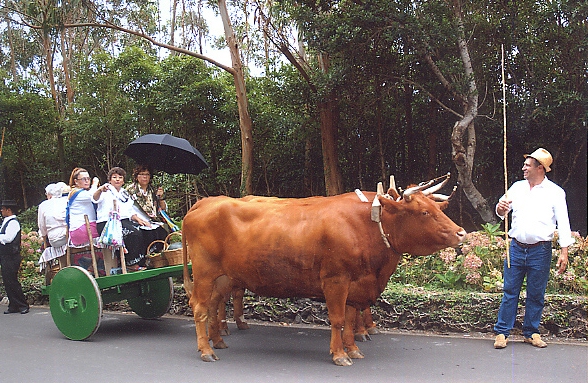 The Ramo Grande is a breed of cattle that hails from the island of Terceira in the Azores, an archipelago off the coast of Portugal. It is named after the plain in the municipality of Praia da Vitória, called Ramo Grande, where the finest examples of this large-format cattle breed can still be found today.
The Ramo Grande is a breed of cattle that hails from the island of Terceira in the Azores, an archipelago off the coast of Portugal. It is named after the plain in the municipality of Praia da Vitória, called Ramo Grande, where the finest examples of this large-format cattle breed can still be found today.
The breed is a result of the early cattle that settlers brought to the island in the 15th century from Portugal and Flanders, which included Alentejan, Mirandese, Minhotan, and Algarvian breeds. Over the centuries, these breeds adapted to the local conditions and became the Ramo Grande. Historically, this breed was used for agricultural work, transportation, and as a source of meat and milk.
However, with the advent of
...
|
 |
|
 Randall Lineback Randall Lineback
|
|
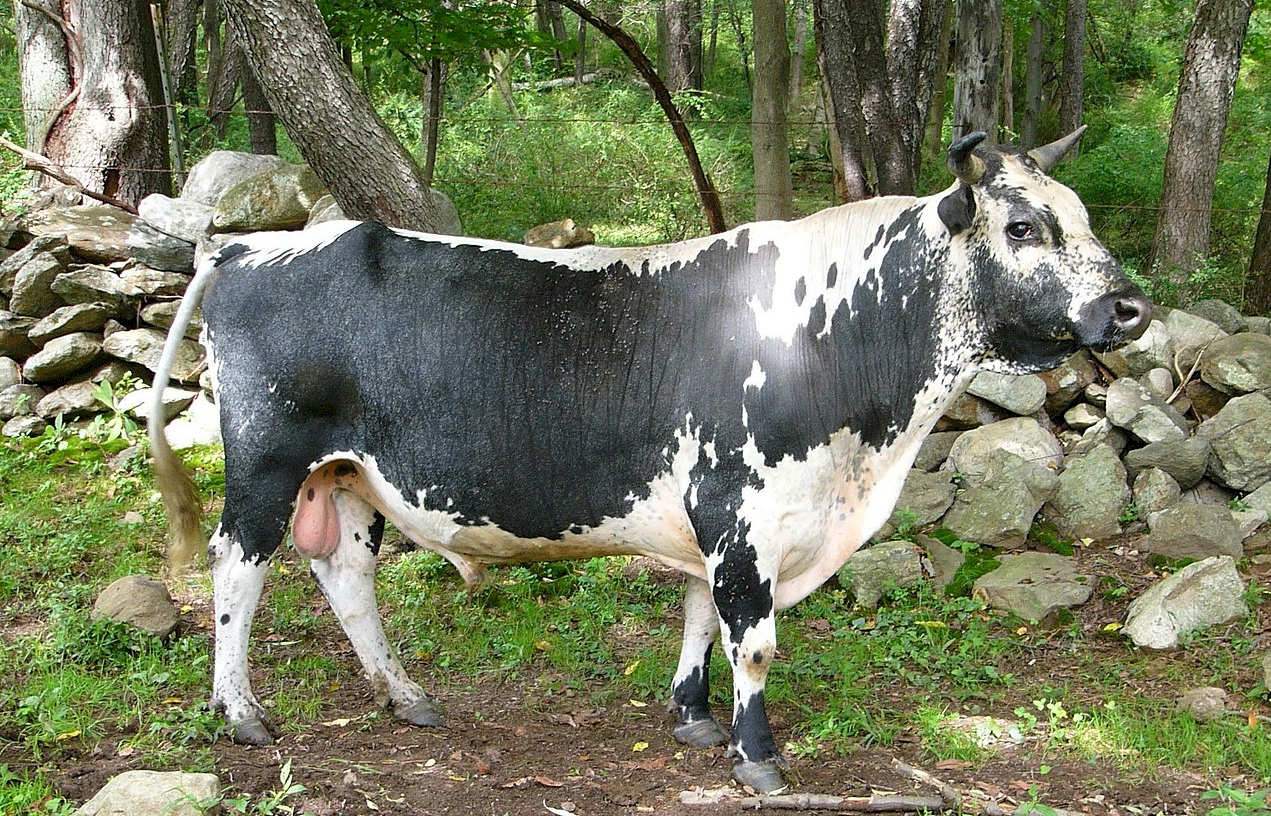 The Randall Lineback, also known as the Randall, is a breed of cattle originating from Bennington County, Vermont in the northeastern United States. It is a triple-purpose breed that was reared for milk, beef, and draft work and is thought to have originated from cattle of British, Dutch, and French origin. The breed was kept largely isolated from other breeds by the Randall family from 1912 until 1985 when it was dispersed, with only six bulls and nine cows being saved for conservation. A breed society was formed in 2005, and in 2022, its conservation status was listed as critical by The Livestock Conservancy. Randalls are medium in size, with cows weighing 600-1100 lbs and bulls weighing 1000-1800 lbs. They have a "Color-sided" pattern of
...
The Randall Lineback, also known as the Randall, is a breed of cattle originating from Bennington County, Vermont in the northeastern United States. It is a triple-purpose breed that was reared for milk, beef, and draft work and is thought to have originated from cattle of British, Dutch, and French origin. The breed was kept largely isolated from other breeds by the Randall family from 1912 until 1985 when it was dispersed, with only six bulls and nine cows being saved for conservation. A breed society was formed in 2005, and in 2022, its conservation status was listed as critical by The Livestock Conservancy. Randalls are medium in size, with cows weighing 600-1100 lbs and bulls weighing 1000-1800 lbs. They have a "Color-sided" pattern of
...
|
 |
|
 Rathi Rathi
|
|
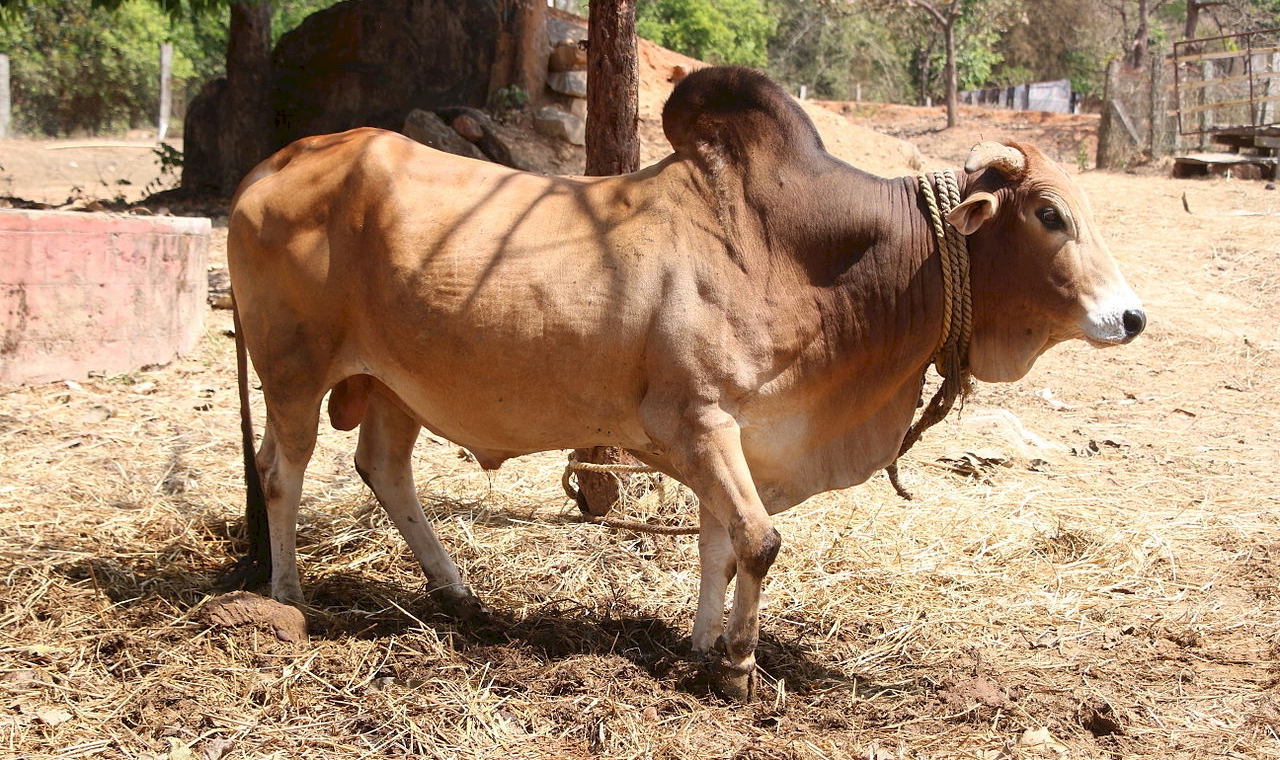 The Rathi (also known as Rath) is a breed of cattle indigenous to India, originating in the region of the state of Rajasthan consisting of Bikaner, Ganganagar, and Hanumangarh districts. It is a dual-purpose breed known for both its milking and draft abilities, with two variants: Rathi is a draft breed and Rath is a pure milch breed. The Rath variant is characterized by its white skin with black or gray spots and originated in the Alwar district of Rajasthan and was domesticated by the Rath tribe. The Rathi variant is usually brown in color. The breed is well suited for the hotter regions of India, such as places in Karnataka like Bellary, Gulbarga, Davanagere, and Sanodoor.
The Rathi (also known as Rath) is a breed of cattle indigenous to India, originating in the region of the state of Rajasthan consisting of Bikaner, Ganganagar, and Hanumangarh districts. It is a dual-purpose breed known for both its milking and draft abilities, with two variants: Rathi is a draft breed and Rath is a pure milch breed. The Rath variant is characterized by its white skin with black or gray spots and originated in the Alwar district of Rajasthan and was domesticated by the Rath tribe. The Rathi variant is usually brown in color. The breed is well suited for the hotter regions of India, such as places in Karnataka like Bellary, Gulbarga, Davanagere, and Sanodoor.
Content and photo source: Wikipedia.org
|
 |
|
 Rätisches Grauvieh Rätisches Grauvieh
|
|
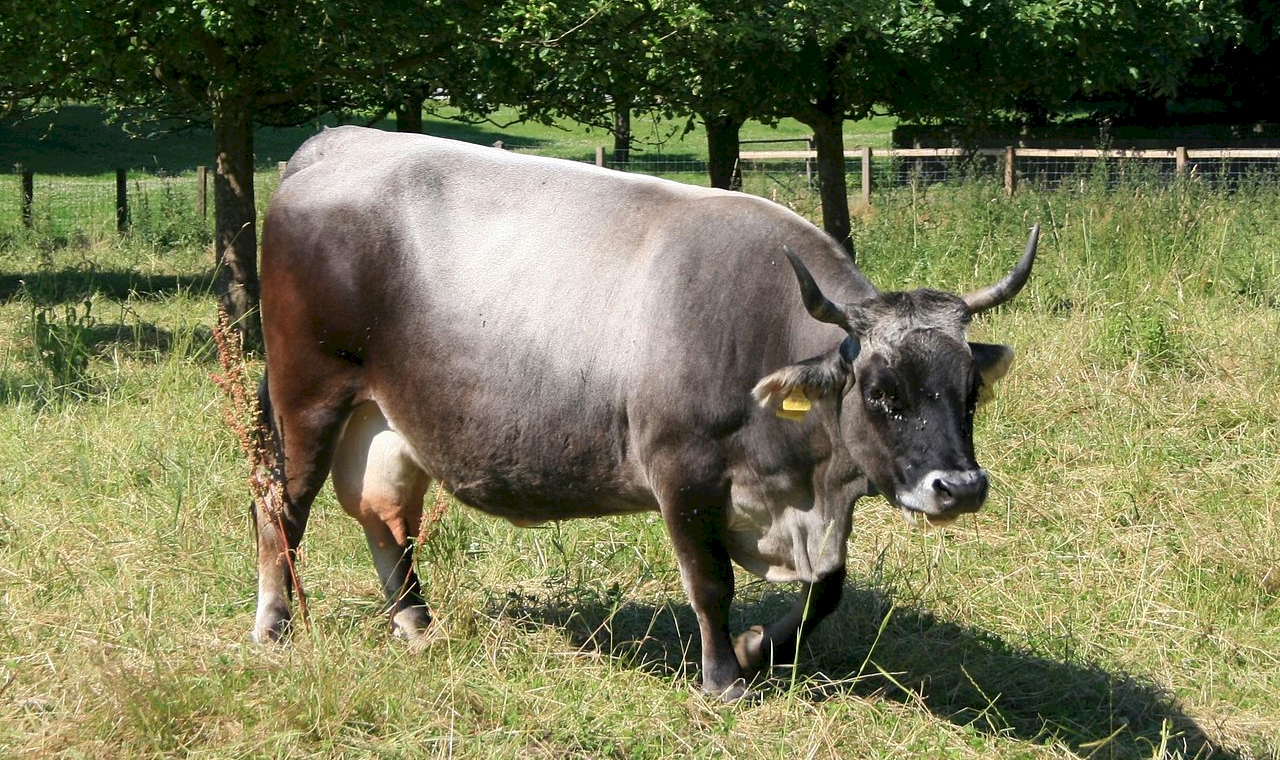 The Rätisches Grauvieh is a small Swiss breed of cattle that originates from the Graubünden region in eastern Switzerland. It is a smaller variety of the Tiroler Grauvieh, which is a breed of Alpine gray cattle. In the 1920s, the Rätisches Grauvieh was merged into the Braunvieh population, but in 1985, cattle of the similar Albula type from Austria were introduced to re-establish the breed. The breed is named after the ancient Roman province of Rhaetia, and it is known for its triple-purpose use as a draft animal, for milk production, and for meat. The breed is considered endangered, with a population of around 2000 reported in 2015.
The Rätisches Grauvieh is a small Swiss breed of cattle that originates from the Graubünden region in eastern Switzerland. It is a smaller variety of the Tiroler Grauvieh, which is a breed of Alpine gray cattle. In the 1920s, the Rätisches Grauvieh was merged into the Braunvieh population, but in 1985, cattle of the similar Albula type from Austria were introduced to re-establish the breed. The breed is named after the ancient Roman province of Rhaetia, and it is known for its triple-purpose use as a draft animal, for milk production, and for meat. The breed is considered endangered, with a population of around 2000 reported in 2015.
Content and photo source: Wikipedia.org
|
 |
|
 Red Angus Red Angus
|
|
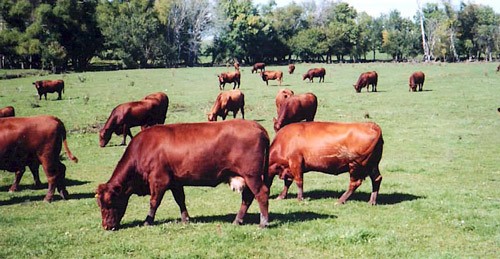 Red Angus cattle originated in the British Isles and first
recorded references to them date back to 1805.
Red Angus cattle originated in the British Isles and first
recorded references to them date back to 1805.
The first Angus herdbook, published in Scotland in 1862,
entered both reds and blacks without distinction. Early in the development of
the breed, Hugh Watson of Keilor, Scotland, arbitrarily decided that black was
the proper color for the breed - he could just as easily have chosen red. The
main difference between Red Angus and black Angus is their color.
|
 |
|
 Red Brangus Red Brangus
|
|
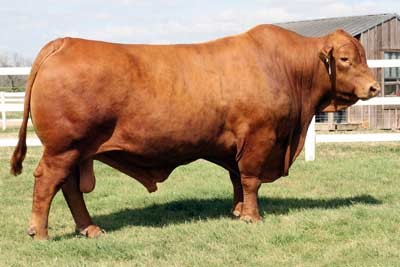 Red Brangus are a blend of 3/8 Brahman and 5/8 Angus (Red or
Black). Red Brangus Cattle have genetics that are ideal for tropical and
sub-tropical regions of the world. Red Brangus Cattle combine the hardiness,
disease resistance and unmatched maternal instincts of the Brahman breed with
the superior carcass quality, fertility, maternal and milking ability of the
Angus. Red Brangus calves are small at birth, averaging 70 to 75 pounds, but
yield high weaning weights. These calves continue to gain efficiently in the
feedlot and yield the lean and tasty Yield Grade 2, Choice carcasses the
consumer demands.
Red Brangus are a blend of 3/8 Brahman and 5/8 Angus (Red or
Black). Red Brangus Cattle have genetics that are ideal for tropical and
sub-tropical regions of the world. Red Brangus Cattle combine the hardiness,
disease resistance and unmatched maternal instincts of the Brahman breed with
the superior carcass quality, fertility, maternal and milking ability of the
Angus. Red Brangus calves are small at birth, averaging 70 to 75 pounds, but
yield high weaning weights. These calves continue to gain efficiently in the
feedlot and yield the lean and tasty Yield Grade 2, Choice carcasses the
consumer demands.
In addition, Red Brangus exhibit early puberty, with heifers
ready to breed at about 14 months and calve on or bef
...
|
 |
|
 Red Fulani Red Fulani
|
|
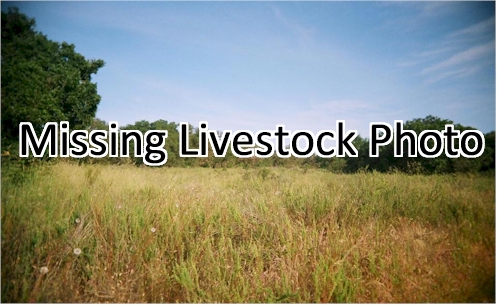 Red Fulani cattle are known for their resilience and adaptability to harsh conditions. Their reddish-brown color and distinctive long lyre-shaped horns make them easily recognizable. This breed of cattle falls into the Sanga type, meaning they are intermediate between Zebu and humpless cattle, and possess cervico-thoracic humps. However, they tend to resemble Zebu more closely than other Sanga cattle. Despite the harsh environments they live in, such as extreme heat, presence of ticks, insect bites, and limited access to water and food, the Red Fulani are able to thrive. They are known by various local names, including Brahaza, Djafoun (Cameroon), Fellata (Chad and Ethiopia), Fogha, Gabassaé, Gadéhé, Hanagamba, Kréda (Chad), Mbororo, Rahaza
...
Red Fulani cattle are known for their resilience and adaptability to harsh conditions. Their reddish-brown color and distinctive long lyre-shaped horns make them easily recognizable. This breed of cattle falls into the Sanga type, meaning they are intermediate between Zebu and humpless cattle, and possess cervico-thoracic humps. However, they tend to resemble Zebu more closely than other Sanga cattle. Despite the harsh environments they live in, such as extreme heat, presence of ticks, insect bites, and limited access to water and food, the Red Fulani are able to thrive. They are known by various local names, including Brahaza, Djafoun (Cameroon), Fellata (Chad and Ethiopia), Fogha, Gabassaé, Gadéhé, Hanagamba, Kréda (Chad), Mbororo, Rahaza
...
|
 |
|
 Red Pied Red Pied
|
|

During the Barbaric Invasions around the year 568 following the new people the herds with a particular red coat; they had robbed this animal in the big plains of southern Russia and Pannonia.
Rustic cows, in that age with triple aptitude and quite good milk producers: they soon become a point of reference for the monks that in the twelfth century started to produce the ancestor of our today’s Parmigiano Reggiano Cheese. There were many breeds in Northern and Central Italy as a matter of fact the Italian Renaissance artistic tradition inserts constantly the red ox in the Nativity’s pictures. This breed was a protagonist (and still is today for its quality) in the agriculture and livestock of the Reggiano and Parma context becaus
...
|
 |
|
 Red Poll Red Poll
|
|
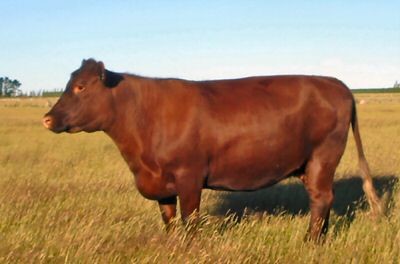 Red Poll Cattle were developed in England from Norfolk and
Suffolk cattle. The resulting cattle were selected for both meat and milk
qualities and became very popular as a dual-purpose breed producing both good quality
milk and beef. Red Poll offspring are highly predictable and uniform. Because
they are only distantly related to many other commercial beef breeds, the Red
poll can impart significant hybrid vigor when crossed with other breeds. Red
Polls were used in the development of the Senopol breed in the Caribbean
beginning in the 1920''s
Red Poll Cattle were developed in England from Norfolk and
Suffolk cattle. The resulting cattle were selected for both meat and milk
qualities and became very popular as a dual-purpose breed producing both good quality
milk and beef. Red Poll offspring are highly predictable and uniform. Because
they are only distantly related to many other commercial beef breeds, the Red
poll can impart significant hybrid vigor when crossed with other breeds. Red
Polls were used in the development of the Senopol breed in the Caribbean
beginning in the 1920''s
Red Polls are known for their fertility, mothering ability,
rapid calf gain, calving ease, forage efficiency, gentle disposition, and lower
fat content. They can vary from lig
...
|
 |
|
 Red Polled Ostland Red Polled Ostland
|
|
 The Red Polled Ostland is a breed of cattle native to Germany. It is also known by other names like "Rotes Oestliches Höhenvieh" and "Rote Polled Ostland." This breed is considered to be a strong and hardy breed, well adapted to the harsh climatic conditions of Eastern Germany. They are usually red in color and have a distinctive polled (without horns) head. These cattle are primarily used for dairy production and have a good reputation for their high-quality milk.
The Red Polled Ostland is a breed of cattle native to Germany. It is also known by other names like "Rotes Oestliches Höhenvieh" and "Rote Polled Ostland." This breed is considered to be a strong and hardy breed, well adapted to the harsh climatic conditions of Eastern Germany. They are usually red in color and have a distinctive polled (without horns) head. These cattle are primarily used for dairy production and have a good reputation for their high-quality milk.
|
 |
|
 Red Sindhi Red Sindhi
|
|
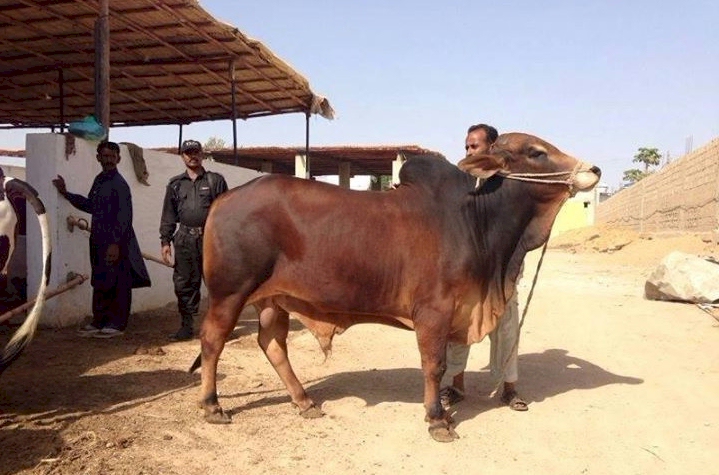 The Red Sindhi cattle are a highly popular Zebu dairy breed originating from the Sindh province of Pakistan. They are widely kept for milk production across countries like Pakistan, India, Bangladesh, Sri Lanka, and others. Their milk production is known to be about 12 to 15 kg per day. To take advantage of their tropical adaptations, such as heat tolerance, tick resistance, disease resistance, and high fertility at high temperatures, they have been widely used for crossbreeding with temperate dairy breeds in many countries, including India, the United States, Australia, Sri Lanka, and others.
The Red Sindhi cattle are a highly popular Zebu dairy breed originating from the Sindh province of Pakistan. They are widely kept for milk production across countries like Pakistan, India, Bangladesh, Sri Lanka, and others. Their milk production is known to be about 12 to 15 kg per day. To take advantage of their tropical adaptations, such as heat tolerance, tick resistance, disease resistance, and high fertility at high temperatures, they have been widely used for crossbreeding with temperate dairy breeds in many countries, including India, the United States, Australia, Sri Lanka, and others.
The Red Sindhi are distinguishable by their deep reddish brown to yellowish red color, with most being deep red. They are also smaller, ro
...
|
 |
|
 Red Steppe Red Steppe
|
|
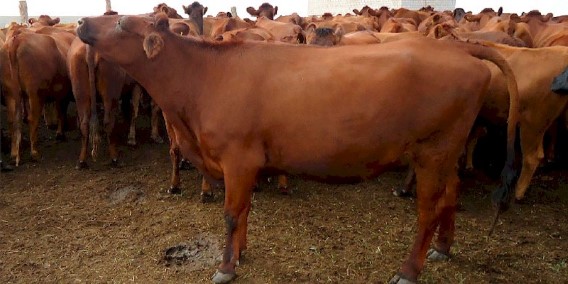 Red Steppe cattle are
considered to be one of the oldest breeds of dairy cattle in the Ukraine. They
originated in the northern part of the former Tavricheskaya province, near the
Molochnaya River.
Red Steppe cattle are
considered to be one of the oldest breeds of dairy cattle in the Ukraine. They
originated in the northern part of the former Tavricheskaya province, near the
Molochnaya River.
During a 150-year breeding period, red steppe cattle
underwent a complex evolutionary path. In the initial period (almost a century)
they were improved only for dairy use. Therefore, they had a number of exterior
deficiencies - narrow-chestedness, a backbone of the back,high-grade and weak development of the
musculature, as well as a small live weight. In the past 40 years, they were
gradually improved both in terms of exterior and constitution, and in
economically useful traits. To date, they are distinguished by a high
...
|
 |
|
 Reina Reina
|
|
 The Reina cattle breed is a dual-purpose breed found in the Mediterranean region, specifically in the province of Valencia in Spain. It is used for both meat and dairy production, and is known for its high resistance to heat and other environmental stress factors. The breed is also known for its strong work ethic, with bulls being used as draught animals and cows being efficient milk producers. The Reina cattle are medium-sized, with a distinctive hump over the shoulders and long, lyre-shaped horns. The breed ranges in color from light reddish-brown to a dark chestnut color.
The Reina cattle breed is a dual-purpose breed found in the Mediterranean region, specifically in the province of Valencia in Spain. It is used for both meat and dairy production, and is known for its high resistance to heat and other environmental stress factors. The breed is also known for its strong work ethic, with bulls being used as draught animals and cows being efficient milk producers. The Reina cattle are medium-sized, with a distinctive hump over the shoulders and long, lyre-shaped horns. The breed ranges in color from light reddish-brown to a dark chestnut color.
|
 |
|
 Rendena Rendena
|
|

The area of origin is Rendena Valley (Trentino). Today this breed is mainly spread in the provinces of Padua, Trento , Vicenza, Verona and other northern Italy provinces. Very rustic, it is suitable to the most difficult grazing areas or in the mountains. Herd book since 1976, it is now slightly increasing after the 80s decrease. It is a very long lasting breed indeed.
Coat color: different shades of brown, darker almost black in the bulls. Harmonious animals; medium-small size and height; straight hair, mulina line with lighter dorsal stripe. Black mucosa, black wide muzzle with white shade. Light horns with black and white tips. Height: 130 cm; weight: 500-550 kg. Ivory hairs in the auricles.
Either suitable for mil
...
|
 |
|
 Retinta Retinta
|
|
 Retinta is a breed of cattle native to Spain. They are known for their distinctive appearance with their large, curved horns and speckled red and white markings on their coats. Retinta cattle are multi-purpose animals, used for both meat and dairy production. They are known for their strong and athletic build, making them well-suited for work in the fields, as well as for bullfighting. They have a docile temperament and are well adapted to the harsh environmental conditions of their native Spain, including heat, drought, and limited grazing resources. The Retinta breed has a long history in Spain, with evidence of their existence dating back to the Roman era. They are a protected breed and efforts are being made to conserve their genetic di
...
Retinta is a breed of cattle native to Spain. They are known for their distinctive appearance with their large, curved horns and speckled red and white markings on their coats. Retinta cattle are multi-purpose animals, used for both meat and dairy production. They are known for their strong and athletic build, making them well-suited for work in the fields, as well as for bullfighting. They have a docile temperament and are well adapted to the harsh environmental conditions of their native Spain, including heat, drought, and limited grazing resources. The Retinta breed has a long history in Spain, with evidence of their existence dating back to the Roman era. They are a protected breed and efforts are being made to conserve their genetic di
...
|
 |
|
 Romagnola Romagnola
|
|
 The origins of the Romagnola breed go very far back,
deriving from the bos taurus macroceros (long-horned aurochs), cattle that
originated in the steppes of Eastern and Central Europe and that gave rise to
various breeds similar in constitution, type, coat and shape of the head and
legs. During the fourth century AD, the barbarian hordes of the Goths, led by
Aginulf, reached Europe with all their goods, including cattle. Part of these
populations settled in the fertile lands of Romagna and their cattle were the
ancestors of the Romagnola breed. Present throughout the modern day provinces
of Forlì, Ravenna, Bologna, Ferrara and Pesaro, this breed has encountered a favorable
environment with a wealth of fodder plants and a good clima
...
The origins of the Romagnola breed go very far back,
deriving from the bos taurus macroceros (long-horned aurochs), cattle that
originated in the steppes of Eastern and Central Europe and that gave rise to
various breeds similar in constitution, type, coat and shape of the head and
legs. During the fourth century AD, the barbarian hordes of the Goths, led by
Aginulf, reached Europe with all their goods, including cattle. Part of these
populations settled in the fertile lands of Romagna and their cattle were the
ancestors of the Romagnola breed. Present throughout the modern day provinces
of Forlì, Ravenna, Bologna, Ferrara and Pesaro, this breed has encountered a favorable
environment with a wealth of fodder plants and a good clima
...
|
 |
|
 Romanian Balata Romanian Balata
|
|
 The Romanian Balata, also known as the Romanian Spotted Cattle, is a breed commonly found in Romania. It is red and white in color and known for its hardiness in harsh environments, making it ideal for both milk and meat production. With an average weight of 600 kg for a mature cow and 900 kg for a bull, and standing between 133-150 cm at the shoulder, the breed is known for its high productivity in terms of both meat and milk. In 2003, its average annual milk production was recorded at 4,500 liters, with a butterfat content of 4% and protein content of 3.2%. This breed is a result of the cross between the Romanian Steppe Grey and the Simmental, which was imported from countries such as Switzerland, Austria, Germany, Czech Republic and Slov
...
The Romanian Balata, also known as the Romanian Spotted Cattle, is a breed commonly found in Romania. It is red and white in color and known for its hardiness in harsh environments, making it ideal for both milk and meat production. With an average weight of 600 kg for a mature cow and 900 kg for a bull, and standing between 133-150 cm at the shoulder, the breed is known for its high productivity in terms of both meat and milk. In 2003, its average annual milk production was recorded at 4,500 liters, with a butterfat content of 4% and protein content of 3.2%. This breed is a result of the cross between the Romanian Steppe Grey and the Simmental, which was imported from countries such as Switzerland, Austria, Germany, Czech Republic and Slov
...
|
 |
|
 Romanian Steppe Gray Romanian Steppe Gray
|
|
 The Romanian Steppe Gray is a breed of cattle native to Romania. It is gray-brown in color, and is used for both dairy and beef production. The breed is known for its hardiness and ability to adapt to harsh environmental conditions. Cows typically weigh around 600 kg and bulls can weigh up to 900 kg. Average annual milk production for the breed is 4,500 liters, with 4% butterfat and 3.2% protein content. The Romanian Steppe Gray has been used as a genetic source for other cattle breeds in Romania and other countries.
The Romanian Steppe Gray is a breed of cattle native to Romania. It is gray-brown in color, and is used for both dairy and beef production. The breed is known for its hardiness and ability to adapt to harsh environmental conditions. Cows typically weigh around 600 kg and bulls can weigh up to 900 kg. Average annual milk production for the breed is 4,500 liters, with 4% butterfat and 3.2% protein content. The Romanian Steppe Gray has been used as a genetic source for other cattle breeds in Romania and other countries.
|
 |
|
 Romosinuano Romosinuano
|
|
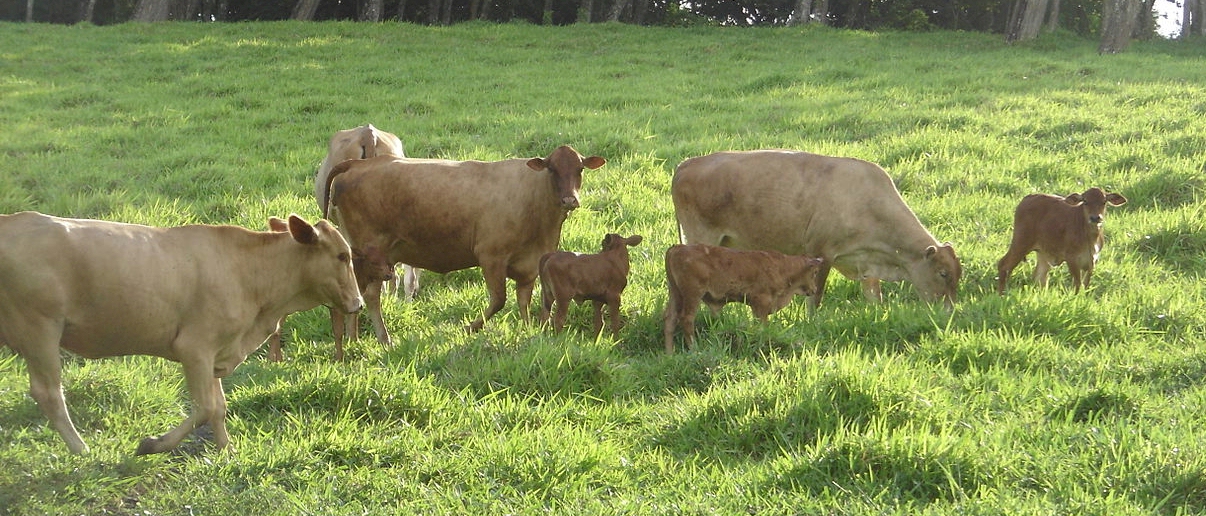 Romosinuano are a naturally-polled cattle from the Sinú River valley, Columbia. The breed was developed from the Spanish Costeño con Cuernos and may have European ancestry from the Angus or Red Poll. Romosinuano are prized for their docility and ability to thrive in subtropical climates, and have spread to Costa Rica and Venezuela. They have also been imported to the United States to improve cattle production in regions with similar climates, like Florida.
Romosinuano are a naturally-polled cattle from the Sinú River valley, Columbia. The breed was developed from the Spanish Costeño con Cuernos and may have European ancestry from the Angus or Red Poll. Romosinuano are prized for their docility and ability to thrive in subtropical climates, and have spread to Costa Rica and Venezuela. They have also been imported to the United States to improve cattle production in regions with similar climates, like Florida.
Content and photo source: Wikipedia.org
|
 |
|
 Rubia Gallega Rubia Gallega
|
|
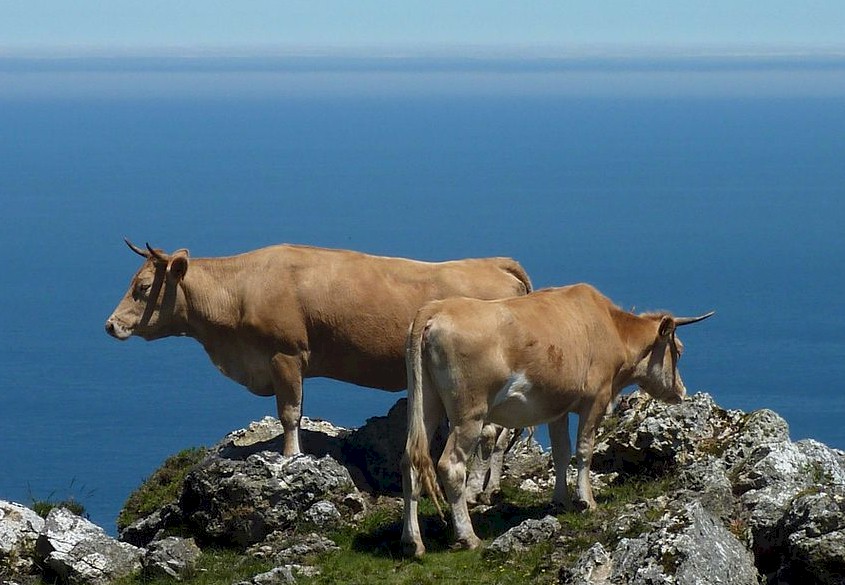 Rubia Gallega ( Galician: Rubia Galega) are a breed of cattle native to the autonomous community of Galicia in north-western Spain. They are found throughout Galicia, with about 75% of the population concentrated in the province of Lugo. They are found particularly at altitudes above 550m in the mountainous areas in the northern part of the province, including the Serra da Carba, the Serra de Lourenzá], and the Serra de Xistral. They are red-blond, wheaten, or cinnamon-colored.
Rubia Gallega ( Galician: Rubia Galega) are a breed of cattle native to the autonomous community of Galicia in north-western Spain. They are found throughout Galicia, with about 75% of the population concentrated in the province of Lugo. They are found particularly at altitudes above 550m in the mountainous areas in the northern part of the province, including the Serra da Carba, the Serra de Lourenzá], and the Serra de Xistral. They are red-blond, wheaten, or cinnamon-colored.
A herdbook was established in 1933. In the 20th century, some crossbreeding occurred with the Portuguese Barrosã, Swiss Braunvieh, Simmental, and British Shorthorn breeds.
Rubia Gallega cattle are primarily for meat; however, their milk is used in t
...
|
 |
|
 Russian Black Pied Russian Black Pied
|
|
 Russian Black Pied cattle were developed from crossing the local cattle in various areas with the Dutch Black Pied and East Friesian breeds. By the beginning of 1980, the number of Black Pied cattle in Russia (excluding the Baltic population) was roughly 16.5 million. They are the second most common breed in the country.
Russian Black Pied cattle were developed from crossing the local cattle in various areas with the Dutch Black Pied and East Friesian breeds. By the beginning of 1980, the number of Black Pied cattle in Russia (excluding the Baltic population) was roughly 16.5 million. They are the second most common breed in the country.
|
 |
|
 RX3 RX3
|
|
 The RX3 cattle breed is a unique composite beef breed, first established in the 1970s, with a strict genetic program. Its name "RX3" symbolizes the merging of three red American breeds to form a superior recombination. The foundation breeds were chosen for the specific genetic traits they would bring to the new breed, and a new germ plasm pool was created for selecting essential traits for a more complete breed.
The RX3 cattle breed is a unique composite beef breed, first established in the 1970s, with a strict genetic program. Its name "RX3" symbolizes the merging of three red American breeds to form a superior recombination. The foundation breeds were chosen for the specific genetic traits they would bring to the new breed, and a new germ plasm pool was created for selecting essential traits for a more complete breed.
The Miles City, MT Livestock Experiment Station used pure Hereford females and bred them with pure Red and White Holstein sires from the Larry Moore Holstein Herd in Suamico, WI, under range conditions in Montana and North Dakota. The Beef Cattle Co. in Johnston, IA, then used pure Red Angus sire Choctaw Chief 373 and his
...
|
 |
